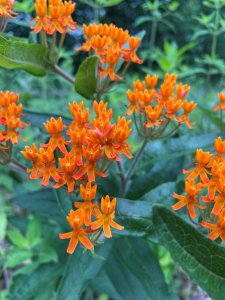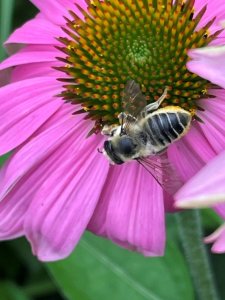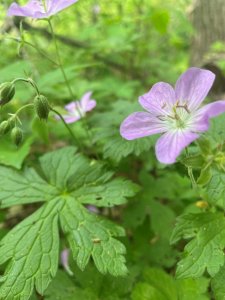Native Plants for Wildlife and Climate
July 19, 2023
By Erin Parker, Interpretive Services Supervisor
Ah, summer! Mid-July is here with all the classic Midwestern heat and humidity, storms that build up in the late afternoon but frequently dissipate before releasing a drop of rain; or, conversely, dump so much water that streets, homes, and gardens are flooded for days. It’s hard to predict exactly how our peak summer months will unfold!

What’s a homeowner (or park manager) to do? Summer droughts means watering lawns and propping up drooping landscaping. Our backyard and park wildlife seek water, shelter, and shade wherever they can find it. Alternating with downpours that saturate the parched soil and drown the root systems of heat-stressed garden plants, it’s a difficult time of year for plant and animal survival.
One way to work with the fluctuating weather and warming summer trends, while supporting indigenous wildlife, is to plant native plants. Native plant gardens can look “messy” or “weedy”, which are common concerns. But they can also look tidy and colorful, and they can save homeowners and park staff time, energy, fuel, and water costs while supporting birds, mammals, insects, reptiles, and amphibians.
Planting for four seasons
Nonnative turf grasses, the green grass that make up most lawns, die back during periods of drought and during the winter. Planting a variety of native plants can bring color, structure, and interest to the landscape across all four seasons.

Consider including plants that flower in spring, summer, and fall, as well as plants that retain their colorful fruits and/or leaves through the winter. Early blooming native wildflowers such as wild geranium (Geranium maculatum) and trout lilies (Erythronium spp.) support bees, ants, and even overwintering butterflies as they emerge on the first warm days of spring. Summer blooms thrive even amidst the hot temperatures and droughts and attract pollinators including variety of butterflies, bees, and beetles. These invertebrates, in turn, feed the voracious appetites of growing songbirds, small mammals, and others. Because indigenous plants have co-evolved with our local plant pests and diseases, they are typically more resilient. This is important because they require much less maintenance- less water, less fighting with pests and diseases, less need for fertilizer or pesticide. Reducing or eliminating the application of pesticides has positive ripple effects throughout our backyard food chains and helps keep our waterways safe for drinking and recreation.
In the fall, native witch hazel (Hamamelis virginiana), a small and delicate shrub has beautiful yellow flowers October- December, adding a splash of color as fall arrives. Michigan holly (Ilex verticillata) retains their bright red berries throughout the winter months, feeding wildlife while adding a festive splash of color to the landscape. Seasonal color also comes from the brilliant red stems and twigs of red osier dogwood (Cornus sericea) which also grows thickly enough to provide food and shelter from cold, wind, and snow.
Planting for diverse structure
The best gardens and garden designers know to plan for diverse structure (height, leaf shape and size, growth habit, etc) to provide the most enticing spaces and views. Creating a native plant garden that takes into consideration these same things improves the way the garden appears to human views, and provides for wildlife biodiversity as well.
Shrubs, vines, small and large trees, and herbaceous plants all have a place in the native plant garden and encourage native wildlife with their preferred food sources, nesting materials, host plants, and shelter throughout the year. Not every garden needs to include all of these types of plants, but considering the ‘bones’ of the garden before planting can add enjoyment and benefits.
Replacing common garden varieties with native plants
Another step that we can take is slowly replacing our nonnative cultivars and horticultural varieties with look-alike indigenous plants. Need the bright splash of yellow that forsythia (Forsythia suspensa, native to China) brings to the still-gray April landscape? Replace it with native spicebush (Lindera benzoin), a beautifully scented and attractive shrub that is an important host plant for spicebush swallowtail butterflies. If vinca (Vinca minor, also commonly called periwinkle, native to parts of Europe and Asia) has been your groundcover of choice, could you replace it with Virginia bluebells (Mertensia virginica) or wild geranium (Geranium maculatum) for a similar splash of purply-blue?

With the growing interest in celebrating and supporting our backyard biodiversity, native plants are becoming easier to find and grow. Look for native plant sales from local nonprofits in the spring and fall and consider if there are plants you could swap out to improve your habitats for wildlife. Small changes can have a big impact, both for the gardener and the garden visitors (human and animal!).
